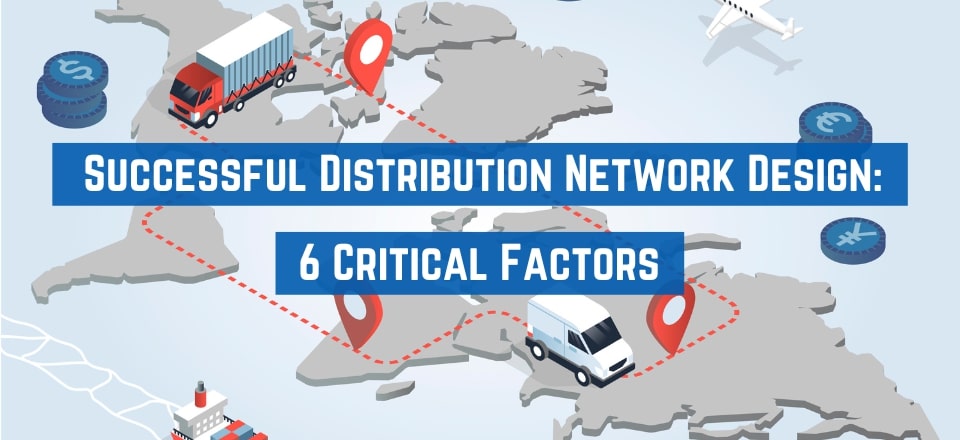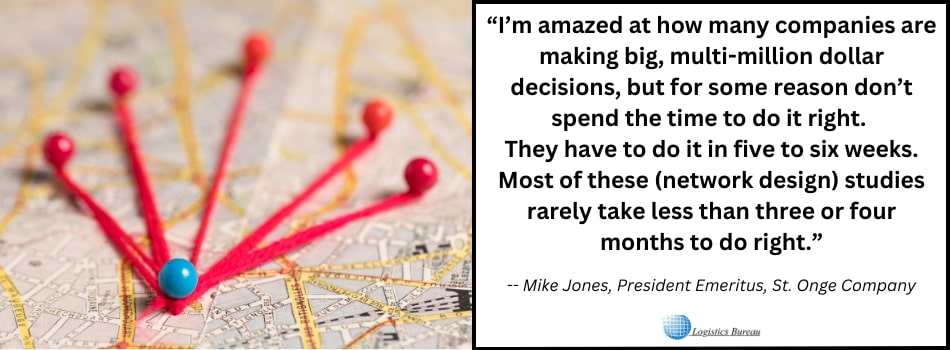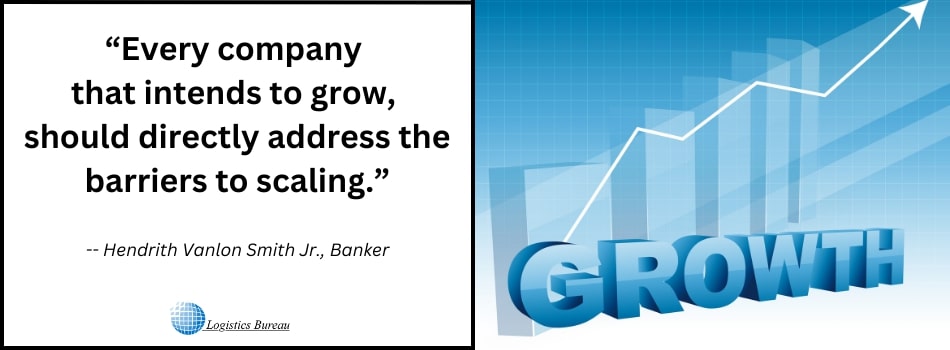If you’ve followed our blog over the years, you’ll know that we’ve shared lots of information about distribution network design, why it’s vital to get it right, how long it should take, the importance of reviewing the network every so often, and various elements of design such as determining the number of warehouses and where to locate them.
In this post, we’re revisiting the topic with a more holistic approach, focusing on six factors that can make the difference between an optimal and suboptimal distribution network design. The information we’re sharing here will be of particular value if you are (or will be) involved in designing a new network or upgrading or expanding an existing one.
1. Quality and Detail of Data and its Analysis
In some of our earlier posts, we’ve stressed the importance of simplicity in distribution network design, and we will return to that topic later in this article. However, the one thing you have in your favour today, which would have been much harder to benefit from in the past, is the capture and analysis of data to inform your design.
It would be folly not to take advantage of data availability and accessibility. So, while simplicity of design is a worthwhile goal, investment of time and resources in comprehensive and detailed data analysis can never be a waste. Indeed, careful attention to data in the preparation stage is indispensable for delivering a simple yet optimal design.
As a primary requirement, it’s necessary to understand the range of data types requiring collection and interpretation. It’s not a short list, so we’ll set it down here as a summary to help you with plans for analysis.
Essential Data for Effective Distribution Network Design
The Data types that you should consider critical for analysis in distribution network design include:
- Customer locations: The geographical distribution of your customer base.
- Customer order history: Historical customer order volumes and frequencies.
- Service requirements: Customers’ service level and delivery lead time expectations.
- Product attributes: Product sizes, weights, and other relevant characteristics.
- Demand variability: The patterns of demand for each product.
- Supplier locations: Geographic locations of your suppliers and their lead times.
- Supplier performance: Reliability and on-time delivery rates of each supplier.
- Inventory levels: Current or expected inventory levels at various locations.
- Inventory turnover: Inventory turns for each SKU.
- Transportation options: Costs and lead times for each available transportation mode.
- Transportation costs: Freight rates, fuel and labour costs, and other transportation expenses.
- Route data: Transportation routes, distances, and transit times.
- Warehouse capacity: The storage capacity and utilisation of existing facilities.
- Throughput rates: The processing capacity of distribution centres.
- Labour productivity: Efficiency and productivity of picking, packing, and shipping activities.
- Market conditions: Data relating to market dynamics, demand shifts, and emerging markets.
- Competitor intelligence: Distribution strategies and network designs of your competitors.
- Regulatory/Legal Compliance: Customs regulations, safety standards, and labour laws.
- Sustainability goals: Evaluate options for eco-friendly distribution processes.
- Fixed costs: Distribution centre fixed costs, such as rent, utilities, and equipment.
- Variable costs: Relating to transportation, labour, and inventory management.
- “What-if” data: Scenario simulation to assess the impact of design options under various conditions.
The Importance of Time and Technology
By gathering and analysing the data we’ve listed above, or as much of it as possible, you will gain credible intelligence to inform decisions about your distribution network design. Of course, it can add up to a vast pool of data, so realistically, access to advanced modelling and analytics tools will be essential to get the most value from it.
Time is another resource you will consume in analysing all this data. If you’d like to know how much time we’re talking about, you’ll find a helpful video on our YouTube channel, discussing timescales for network design at various levels of detail. Why not take a look at it now, using the button below?
2. Clarification of Design Objectives
While the need to start a distribution network design project by focusing on objectives may seem obvious, you might be surprised at how many companies either omit this step or settle for defining an overarching objective such as cost reduction or geographic expansion.
To do so is a mistake because a successful and future-proof distribution network design will typically need to meet several objectives. While there may well be a single primary goal for the network, such as expanding into a new region, other factors will likely merit serious consideration, too.
For at least some of these design aspects, a clearly defined goal will ensure their potential impacts stand out amid the big picture and will also be helpful when it comes to scenario modelling.
First and foremost, of course, you should ensure the objectives for your distribution network align with those of your supply chain strategy, which in turn should support the overall goals of your business. Again, we mention this because strategy misalignment is an issue we often encounter in our work with clients, often leading to—or exacerbating—many challenges that could otherwise have been avoidable.
Some Common Distribution Network Objectives
Aside from alignment with business objectives, network design requires a clear, cross-functional understanding of complementary or secondary goals, which, for example, might include any of the following:
|
|
Whatever the goals of your distribution network, they should form a central tenet of its design. By ensuring that all stakeholders are aware of, and in agreement with them, they will remain in sharp focus during decision-making, preventing the design from lapsing into aimlessness.
3. A Focus on Simplicity
In an earlier paragraph, we mentioned the importance of simplicity and that it would feature as a topic in this article. As promised then, we’ll look now at the need to minimise design complexity, focusing on some of the possibilities to keep your distribution network as simple as feasibly possible.
Process Standardisation
It’s not only the physical network, as in the location of distribution centres and warehouses that you must consider in the drive for simplicity. It’s vital to think about your processes, too. By standardising distribution processes across your network, you can simplify operations for economy and efficiency.
Order picking, packing, transportation processes, and inventory management practices and procedures are all worthy targets for standardisation.
Optimised Facility Location
If you are designing a new distribution network from scratch, naturally, you can plan for an optimal approach to the locations of distribution centres and warehouses. Things can become more challenging when designing improvements to an existing network.
In this case, evaluating the number and locations of your facilities makes sense. Consolidate or close any underutilised warehouses or those you believe can be omitted from your network without any significant negative impact.
In our work with clients, we often succeed in making an existing network more effective by removing a distribution node or two. For a new network, it will certainly be worth comparing the trade-offs involved in operating several small distribution centres versus fewer but more extensive facilities.
Keeping distribution centres to a minimum can help you avoid excessive complexity in your distribution network while simultaneously offering the potential for cost savings.
Rationalised Routing
Whether creating a new network or revising an existing one, beware of complexities arising from transportation choices, especially when planning your DC locations. Try to avoid introducing the need for backtracking and detours in transportation.
For instance, ask yourself if you genuinely need a warehouse in a given location or whether a cross-docking operation, which requires little storage space and presents no on-site inventory management complexities, would suffice.
You may have noted how; interestingly, we drift back to the warehouse/DC location topic when discussing transportation and routing. If you’re wondering why that’s so, know that the number and location of hubs in your network will significantly influence your primary and secondary distribution routing.
It’s worth remembering, for example, that secondary distribution tends to generate higher transportation costs than primary distribution. That’s why you’ll need to seek a balance between keeping inventory close to your customers (to reduce outbound logistics costs) and keeping the number of warehouses in your network as low as possible.
Avoid “Complexity Creep”
It’s all very well to aim for simplicity in a distribution network design, and indeed, if you achieve it, you can consider it a win. But even then, the initial level of simplicity will probably not endure for more than a few years, and complexities may even begin to creep in faster than you would expect.
Remember, market conditions can change rapidly, especially these days, meaning that regular reviews of your distribution network are essential to check for evidence of this “complexity creep”.
One way to avoid complexity creep is to build scalability into the distribution network design, an initiative which we will cover in detail in point no. 4 of this article.
Beware of Over-engineering the Design Process
Finally, while we’re on the topic of complexity, remember that it’s possible to overcomplicate the actual design process and that, too, can lead to unnecessarily complex results.
If that assertion needs some elaboration, we’re saying that while many of the points covered in this article will be most relevant for larger organisations requiring substantial network coverage, some will be useful for less ambitious network design projects. In such cases, the design process can often be kept relatively simple, demanding less time and requiring less sophistication in the tools used.
In our video, Distribution Network Analysis, we offer insights into the time required to complete a distribution network design project using various tools and approaches, from the back of an envelope to the sophisticated and detailed studies necessary for a network with extensive coverage.
4. Built-in Scalability
This topic makes an appropriate addendum to the discussion about the simplicity of your network because one of the factors that often drives increased complexity is business growth.
Any substantial increases in distribution volume can lead to capacity bottlenecks, potentially requiring the addition of new warehouses to serve as overflows for your existing facilities.
However, additional warehouses add complexity to the network, not only because they exert more pressure on your shipping and transportation operations but also because they increase the inventory management burden.
New warehouses can also add complexity to the demand side of your network, sometimes requiring adjustments to supplier agreements or even generating a need for additional suppliers.
The good news is that there are ways to avoid network complexity arising from business growth. One approach is to design your network to be scalable. So, let’s move on now to look at how you can do that.
Flexible Facilities
To allow for future increases in warehouse capacity, it can pay to design your facilities to be flexible. There are several ways to do so.
One possibility is to develop expandable infrastructure and acquire facilities with plenty of yard space. That will afford you the option to expand the physical dimensions of the warehouse if (or when) it should become necessary.
Of course, this can be costly, but comparatively less so than retroactive warehouse leasing, purchasing additional warehouses, or relocating an entire DC operation to larger premises.
Design for Partnership
Another way to build scalability into your distribution network is to design it in partnership with one or more 3PL providers, or to design with the express intention of working with 3PLs in some geographic regions or locations.
Naturally, you must identify and work with providers offering warehousing services in your chosen locations and the ability to scale their resources to meet your future operational needs.
This approach can reduce the capital costs involved in your network setup. It also provides the on-demand scalability that will not be present in a network relying solely on assets owned or leased by your company.
A similar methodology might be appropriate for the transportation aspect of your distribution network. By designing the network to be served by 3PL providers or planning to work with a combination of carriers, you can enhance your company’s ability to scale its distribution operation as necessary.
5. Consider the Inventory Impact
Network design projects often neglect to plan sufficiently for inventory deployment into a new distribution network. It’s an oversight we recommend that you avoid since the success of a network depends on how well you factor inventory management into your design.
Indeed, the more DCs and warehouses your network will comprise, the more its success will depend on inventory optimisation, and the best time to optimise inventory is during the design process, after determining the number and location of facilities required.
Getting Complicated? Get Some Help
Of course, inventory optimisation is not a task to take lightly. To pull it off during network design, you will need access to software sophisticated enough to run algorithms, enabling you to model scenarios and find a balance between meeting required service levels and minimising inventory carrying costs.
It’s vital to remember, too, that optimal results depend not just on stocking strategies for each warehouse but also on other factors like transportation routing and individual facility design.
Therefore, engaging a consulting partner to assist you is a good idea. A good consulting firm can give you access to the tools you need, along with the expertise and experience of people who design distribution networks regularly.
6. Design for Sustainability
Eco-friendly distribution is a judicious goal for a new network design and a noble justification for reviewing and adjusting an existing one. It’s also a goal that, when achieved, significantly contributes to overall network success.
Does this mean that you should disregard all other network design goals? Not at all.
After all, the distribution network is only a means to an end for just about every business, so it would be folly to focus on maximising sustainability to the exclusion of every other consideration.
Nevertheless, we’re recommending sustainability as a success factor to consider because of the many ways in which it can benefit your organisation, aside from the obvious contribution to the war against environmental degradation.
Stakeholders Look for Sustainability
Let’s look at the reputational benefits first, because a clear commitment to reducing the environmental impact of your distribution network is a strong selling point in any area of commerce and industry.
For example, a positive reputation for sustainable practices can bring your company to the attention of an increasingly large sector of society concerned about our planet’s future. That includes environmentally conscious customers, giving them a reason to choose your company over competitors that score lower in the corporate social responsibility stakes.
While that might be an advantage that fades over time, as more and more companies, quite correctly, increase their focus on sustainable business, there is a lot to be said for winning over these customers early. And there’s time yet to garner a sense of loyalty among them, strengthening your hand later against competitors that are slower to show their environmental commitment.
Along with customers, investors and stakeholders are also likely to consider a company’s environmental and social responsibility when making decisions. A commitment to sustainability can attract responsible investors and satisfy stakeholder demands.
Sustainability’s Impact on Cost, Efficiency, and Service
Sustainability benefits are not limited to corporate marketability. There are operational wins to be had, too. A primary goal of sustainability in a network is to reduce resource consumption and waste, which can result in cost savings.
For instance, designing the transportation network to minimise fuel usage can lower fuel costs, while energy-efficient facilities reduce electricity expenses.
Moreover, sustainable network design can also yield efficiency gains in your logistics operation, making for smoother processes and shorter lead times. That, in turn, can boost your customer service performance.
For a Better Distribution Network, Design for Success
While any logistics professional involved in distribution network design would naturally strive to achieve the best possible results, the success factors discussed in this article, for one reason or another, often get overlooked in the design process or simply don’t receive enough emphasis.
To sum up then, and help you keep these “golden rules” in mind, your chances of designing a distribution network that supports your enterprise and its customers effectively, and serves you well into the future (but remember to reassess the design from time to time and adjust for changes in market conditions), will be enhanced by a focus on the following:
- Attention to the quality and detail of data analysis
- Clarification of both primary and secondary objectives of the network
- Simplicity wherever feasible
- Building scalability into the network design
- The importance of inventory optimisation
- The value of sustainability
And if you’d like some more related insights, particularly regarding possible approaches to distribution network design—and a realistic idea of how long you should expect the design process to take, have a look at that video we mentioned. You can get to it directly from the banner below.
Editor’s Note: The content of this post was originally published on Logistics Bureau’s website dated October 10, 2023, under the title “6 Critical Success Factors in Distribution Network Design“.










